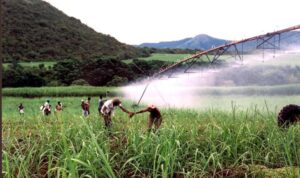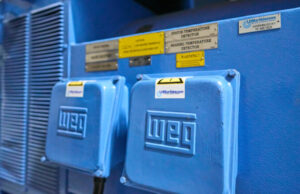Introduction
Rain does not always fall where humans want it to fall, but we work with it to our own advantage.
On a national level, dams such as the Gariep Dam, Vanderkloof Dam, Midmar Dam, Pongolapoort Dam, Vaal Dam or Theewaterskoof Dam have been constructed to collect and store rain water on a large scale. To address the country’s needs, government plans to build new dams or expand existing ones at Mzimvubu River (Eastern Cape), Clanwilliam Dam (Western Cape), the Nwamitwa Dam and Tzaneen Dam (Limpopo), the Hazelmere Dam (KwaZulu-Natal) and the Polihali Dam (in Lesotho to provide water to Gauteng).
On a local or farming level, thousands of smaller dams have been built by the owners of the land, using their tractors, dam scrapers, front-end loaders or other equipment available on the farm. At a later date this water will be used for irrigating crops, drinking water for animals and even as drinking water for human consumption.
The companies listed on this page are involved in water storage. Other companies involved in the water sector are listed on the general “Water” page.
Summary of legal requirements for prospective and existing dam owners in South Africa
All relevant forms and contact details can be downloaded from www.dws.gov.za.
There are three legal requirements that must be met before a person may construct/alter/repair a dam, namely with regard to (1) dam safety, (2) entitlement to water use, and (3) the environment. The requirements for prospective as well as for owners of existing dams are summarised below.
- DAM SAFETY LEGISLATION
The dam safety legislation is covered by chapter 12 of the National Water Act, 1998 (Act 36 of 1998) [NWA] and by dam safety regulations, published in Government Notice R. 139 of 24 February 2012.
Only dams with a safety risk (that is dams with a maximum wall height exceeding 5,0 m and with a storage capacity exceeding 50 000 m3, or any other dam declared by the Minister as a dam with a safety risk) are subject to these Regulations.
These Regulations are administered by the Dam Safety Office within the Department of Water and Sanitation (hereafter Department). The requirements of the dam safety regulations are summarised below:
New dams, enlargement, alteration or repair of existing dams
The first step is to confirm the entitlement to water use at the relevant Regional Office (to prevent fruitless expenditure).
The next step is to apply for classification of the dam on form DW 692E. The Department will then inform the applicant of the classification of the dam and of further procedures.
If the dam is classified as a category I dam, apply for a licence to construct on form DW 694E and submit a design report and engineering drawings as specified in regulations 4 to 8. Construction may only commence after the licence to construct has been issued.
If the dam is classified as a category II or III dam, the services of an approved professional person (APP) must first be obtained. The APP must apply for a licence to construct on behalf of the dam owner (this involves the submission of an application form, design report, engineering drawings and project specifications as specified in regulations 10 to 21). Construction may only commence after the licence to construct has been issued.
The APP must also ensure that an adequate quality control programme is in place during the construction period. Before starting with storage of water, the APP must apply for a licence to impound water (this involves the submission of an operation & maintenance manual and emergency preparedness plan together with an application form DW 696E and construction progress report). After completion of all construction work, the APP must submit a completion report, completion drawings and a completion certificate stating that the work has been completed according to his/her specifications.
Existing dams
All dams with a safety risk as defined in paragraph 1 above, must be registered on form DW 693E.
The Department must be notified of any changes of particulars (ownership, address, telephone numbers, person in control, etc.)
The dam must be operated and maintained in a responsible manner. Basically this requires that the owner, or the person appointed by the owner, must visit and inspect the dam on a regular basis (at least weekly). Maintenance work must be done regularly. In the case of unsafe conditions, emergency procedures and safety measures must be taken and the Department informed thereof.
The dam owner must arrange for the execution of a formal dam safety evaluation including inspection when instructed to do so by the Department (at intervals between 5 and 10 years). In the case of category II and III dams the evaluation must be done by an APP. In the case of category I dams it is not prescribed by whom the evaluation must be done but it is in the owner’s interest to appoint an experienced and qualified person to perform this task. If necessary, the dam safety evaluation report should indicate what work must be done to upgrade the dam to acceptable safety standards.
2. ENTITLEMENT TO WATER USE (administered by the Regional Offices of the Department)
Any new water use as defined in section 21 of the NWA is subject to licensing. Just “storing water” is also defined as a water use! There is no guarantee that a licence will be issued as it is subject to availability of water and a number of conditions and constraints in the NWA.
Before construction of any new dam or enlargement/alteration/repair of an existing dam may start, a water use licence or written authorisation/confirmation must be obtained from the Regional Director of the relevant region of the Department.
In the case of dams that failed, the existing lawful water use status (subject to verification) will normally be acknowledged but it is essential that confirmation be obtained in writing from the Regional Director in order to avoid fruitless expenditure.
Existing dams: Section 21(b) of the NWA defines storage of water as a water use. Generally, if more than 10 000 m3 of water is stored per registered property, then that water use must be registered on a form that will be supplied by the Regional Director for this purpose. However, in some Water Management Areas the general authorisation does not allow any dam, irrespective of size, outside the licensing procedure and in those areas all dams must be registered.
3. ENVIRONMENTAL LEGISLATION (Administered by relevant provincial department)
The provisions and regulations of Government Notices Nos. R. 543 to R. 547, dated 18 June 2010, promulgated in terms of the National Environmental Management Act, 1998 (Act No. 107 of 1998) regarding control over activities which may have a detrimental effect on the environment, must be complied with. Normally it will be required that an environmental impact assessment (EIA) must be carried out before construction of a new dam or enlargement/repair of an existing dam will be authorised. Written authorisation must be obtained from the relevant provincial government department before commencing with the project.
Source: www.dws.gov.za/dso/Documents/Summary%20Legal%20Requirements%20Dams%202013-12-03.pdf
National Strategy and government contact
Department of Water and Sanitation (DWS)
A Water Use Licence or other appropriate authorisation must be obtained from the regional offices. Contact details can be found on www.dws.gov.za (“Customer Care” and “Provincial Contacts” options).
Additional information regarding national norms and standards on water storage for irrigation purposes can also be obtained from the Department of Agriculture, Land Reform and Rural Development (DALRRD):
Department of Agriculture, Land Reform and Rural Development (DALRRD)
- Directorate: Water Use and irrigation Development, DWUID [at] dalrrd.gov.za and MaryJeanG [at] dalrrd.gov.za
- Directorate: Infrastructure Support, DINFRAS [at] dalrrd.gov.za
Role players
Websites and publications
Call 012 842 4017 or email iaeinfo [at] arc.agric.za for the following publications, available from the ARC in Silverton (these publications are also available in Afrikaans):
- Earth Dams
- Manual for the building of circular reservoirs
- Affordable round dam for farms: a do-it-yourself manual
Information and statistics on water can be found on www.wrc.org.za, website of the Water Research Commission.
Information on the daily and weekly flow into the major dams can be found on www.dws.gov.za.
Some articles:
- Find the blog “Dam owners called to register their dams within 60 days” at www.agribook.co.za.
- Kemp C. 2024, November 29. “Ongeregistreerde damme: Twee maande kans om te registreer” [Unregistered dams: Two months to register]. Landbouweekblad. Available at www.landbou.com/landbou/bedrywe/bedryfsake/damregistrasie-twee-maande-kans-om-te-registreer-20241129
- Reporter. 2024, August 11. “Water portfolio committee calls for enhanced monitoring to ensure dam safety”. SA News. Available at www.sanews.gov.za/south-africa/water-portfolio-committee-calls-enhanced-monitoring-ensure-dam-safety
- Arnoldi M. 2024, July 9. “Water attorney unpacks water-use right considerations for the agriculture sector”. Engineering News. Available at www.engineeringnews.co.za/article/water-attorney-unpacks-water-use-right-considerations-for-the-agriculture-sector-2024-07-09
- Reporter. 2023, January 27. “KZN farmer fined R1.5m for illegal water use”. SA News. Available at www.sanews.gov.za/south-africa/kzn-farmer-fined-r15m-illegal-water-use
- Reporter. 2021, December 8. “What To Consider Before Building A Dam”. SA Small holder. Available at https://sasmallholder.co.za/2021/12/08/building-a-dam/
- Reporter. 2019, November 15. “Dam owners urged to stick to the rules”. SA News. Available at www.sanews.gov.za/south-africa/dam-owners-urged-stick-rules
- Palm, K. 2019, June 19. “R3.5m fine for farmer after he failed to apply for licence to build dams”. Eye Witness News. Available at https://ewn.co.za/2019/06/19/r3-5m-fine-for-farmer-after-he-failed-to-apply-for-licence-to-build-dams
- Find the article “Agricultural Dams Provide Drought Insurance” at www.mbb.co.za/facts-news/projects/agricultural-dams-provide-drought-insurance.






